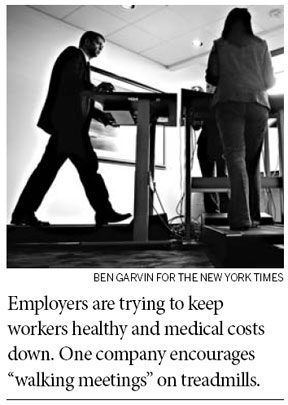Turning the office into a gym
Updated: 2012-02-05 08:02
By Eric V. Copage (The New York Times)
|
|||||||||||
Every day, millions of workers do something dangerous to their health: they sit down.
Sitting for long periods is hard on the body. It strains the back and causes the muscles to become slack. It slows the processes that metabolize calories, increasing the risk of obesity, diabetes, heart disease and some cancers.
People might think they are protecting themselves from such problems if they exercise outside of working hours. But regular exercise doesn't entirely make up for the shutdown of chemical processes during long periods of sitting, research has shown.
There is a solution: get up and move throughout the workday. Workers can sit on an exercise ball or stand while working, use the stairs instead of the elevator, or even walk over to a co-worker's desk instead of sending an instant message. Every little bit helps.
Now some employers hope to improve their employees' health and to lower medical costs too.

Salo, a financial staffing firm in Minneapolis, encourages walking meetings. In a conference room, Salo has set up four treadmill desks with a height-adjustable working surface, so that people can walk and take care of business at the same time.
"It took a bit of adjustment," said Craig Dexheimer, Salo's director of operations and administration. In a separate room, Salo has set up six treadmill desks with computers. Employees can also take Ping-Pong breaks.
In 2007, Mr. Dexheimer helped organize a study headed by Dr. James A. Levine at the Mayo Clinic on the effects of increased movement in the workplace.
For six months, 18 employees were monitored with a device on their belts. Using the treadmill desks and wireless headsets that permit walking while talking on the phone, the employees collectively lost more than 68 kilograms, most of it in body fat. Their cholesterol and triglyceride levels also showed a collective decline.
Toni Yancey, a professor in the department of health services at the University of California, Los Angeles, has found that some workers do best with "structured group activity breaks."
At HealthBridge, a clinic in Great Neck, New York, an employees' area resembles a mini-exercise room. During a break, one employee might do bicep curls using water bottles, while another might attempt triceps dips.
The program, introduced to giggles and skepticism two years ago, has since been embraced by most of the clinic's 25 employees, said Jennifer Alexatos, the marketing manager.
New Balance, the footwear company based in Boston, tried a 30-day pilot program that included sending daily e-mail messages to employees with ideas for staying active at work. The company plans to expand the program.
"I swapped out my chair for a balance ball," said Lisa Mahoney, an associate marketing manager at the company. "You're always moving a little bit when you're on the phone or typing your e-mail."
She also gets up more often and takes the stairs. "You have a burst of energy when you come back to your desk," she said.
The New York Times
Today's Top News
Rescuers race against time for quake victims
Telecom workers restore links
Coal mine blast kills 18 in Jilin
Intl scholarship puts China on the map
More bird flu patients discharged
Gold loses sheen, but still a safe bet
US 'turns blind eye to human rights'
Telecom workers restore links
Hot Topics
Lunar probe , China growth forecasts, Emission rules get tougher, China seen through 'colored lens', International board,
Editor's Picks

|

|

|

|

|

|





